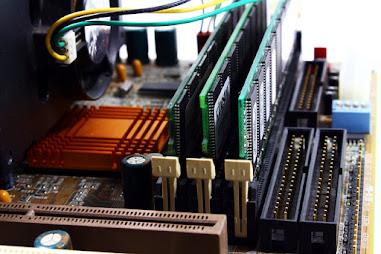RAM(Random Access Memory)
may be a a part of computer’s Main Memory that is directly accessible by processor. RAM is employed to scan and Write information into it that is accessed by processor willy-nilly. RAM is volatile in nature, it suggests that if the ability pops, the hold on data is lost. RAM is employed to store the info that's presently processed by the processor. Most of the programs and information that area unit modifiable area unit hold on in RAM.
Integrated RAM chips area unit on the market in 2 form:
SRAM(Static RAM)
DRAM(Dynamic RAM)
The SRAM reminiscences include circuits capable of retentive the hold on data as long because the power is applied. which means this kind of memory needs constant power. SRAM reminiscences area unit accustomed build Cache Memory.
SRAM Memory Cell: Static reminiscences(SRAM) area unit memories that include circuits capable of retentive their state as long as power is on. so this kind of reminiscences is named volatile reminiscences. The below figure shows a cell diagram of SRAM. A latch is made by 2 inverters connected as shown within the figure. 2 transistors T1 and T2 area unit used for connecting the latch with 2 bit lines. the aim of those transistors is to act as switches that may be opened or closed below the management of the word line, that is controlled by the address decoder. once the word line is at 0-level, the transistors area unit turned off and therefore the latch remains its data. for instance, the cell is at state one if the logic price at purpose A is one and at purpose B is zero. This state is maintained as long because the word line isn't activated.
For scan operation, the word line is activated by the address input to the address decoder. The activated word line closes each the transistors (switches) T1 and T2. Then the bit values at points A and B will transmit to their individual bit lines. The sense/write circuit at the tip of the bit lines sends the output to the processor.
For Write operation, the address provided to the decoder activates the word line to shut each the switches. Then the bit price that to be written into the cell is provided through the sense/write circuit and therefore the signals in bit lines area unit then hold on within the cell.
DRAM
DRAM stores the binary data within the kind of electrical charges that applied to capacitors. The hold on data on the capacitors tend to lose over a amount of your time and so the capacitors should be sporadically recharged to retain their usage. the most memory is usually created from DRAM chips.
DRAM Memory Cell: although SRAM is incredibly quick, however it's big-ticket attributable to its each cell needs many transistors. comparatively more cost-effective RAM is DRAM, because of the utilization of 1 semiconductor unit and one capacitance in every cell, as shown within the below figure., wherever C is that the capacitance and T is that the semiconductor unit. data is hold on during a DRAM cell within the kind of a charge on a capacitance and this charge must be sporadically recharged.
For storing data during this cell, semiconductor unit T is turned on ANd an acceptable voltage is applied to the bit line. This causes a best-known quantity of charge to be hold on within the capacitance. once the semiconductor unit is turned off, because of the property of the capacitance, it starts to discharge. Hence, the data hold on within the cell may be scan properly given that it's scan before the charge on the capacitors drops below some threshold price.
Types of DRAM
There area unit chiefly five sorts of DRAM:
Asynchronous DRAM (ADRAM): The DRAM represented on top of is that the asynchronous sort DRAM. The temporal order of the device is controlled asynchronously. A specialised memory managementler circuit generates the mandatory control signals to manage the temporal order. The processor should take into consideration the delay within the response of the memory.
Synchronous DRAM (SDRAM): These RAM chips’ access speed is directly synchronous with the CPU’s clock. For this, the memory chips stay prepared for operation once the processor expects them to be prepared. s. SDRAM is commercially on the market as modules incorporating multiple SDRAM chips and forming the desired capability for the modules.
Double-Data-Rate SDRAM (DDR SDRAM): This quicker version of SDRAM performs its operations on each edges of the clock signal; whereas a regular SDRAM performs its operations on the rising fringe of the clock signal. Since they transfer information on each edges of the clock, the info transfer rate is doubled. To access the info at high rate, the memory cells area unit organized into 2 teams. every cluster is accessed on an individual basis.
Rambus DRAM (RDRAM): The RDRAM provides a really high information transfer rate over a slim CPU-memory bus. It uses varied speeding mechanisms, like synchronous memory interface, caching within the DRAM chips and extremely quick signal temporal order. The Rambus information bus dimension is eight or nine bits.
Cache DRAM (CDRAM): This memory may be a special sort DRAM memory with AN on-chip cache memory buffer the most dynamic RAM


ConversionConversion EmoticonEmoticon